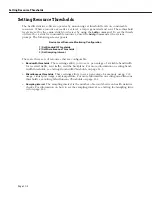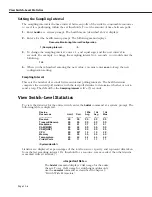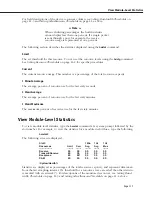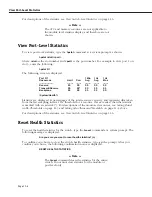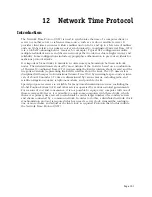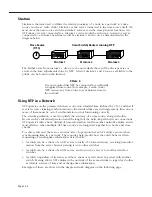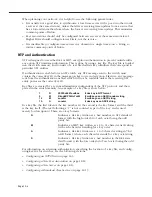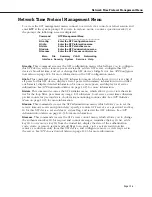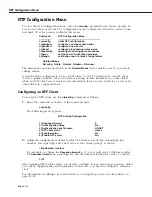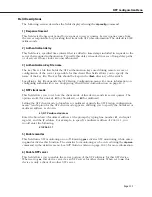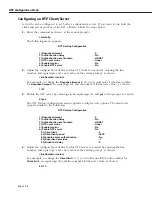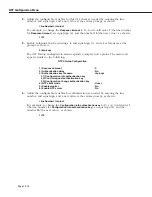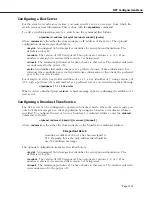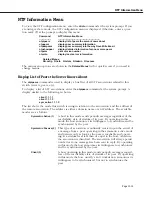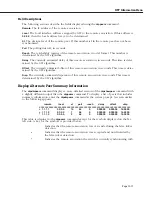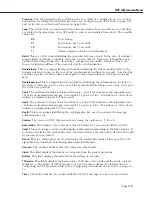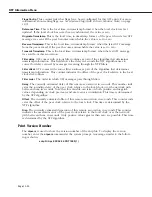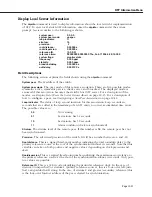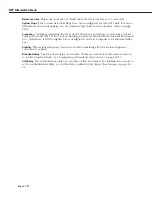
NTP Configuration Menu
Page 12-7
Field Descriptions
The following section describes the fields displayed using the
ntpconfig
command.
1) Response timeout
This field sets the timeout period for responses to server queries. Server queries come from
the server responsible for providing this client with
NTP
time information. The default is 8000
milliseconds.
2) Authentication delay
This field sets a specified time interval that is added to timestamps included in requests to the
server that required authentication. Typically this delay is needed in cases of long delay paths,
or of servers whose clocks are unsynchronized.
3) Authentication key file name
The key file is a file that holds the
NTP
authentication keys used during remote access or
configuration of the server responsible for this client. This fields allows you to specify the
name of the key file. The key file should be kept in the
/flash
directory of the switch.
Specifying a key file expands the
NTP
Startup Configuration menu. For more information on
configuring authentication, see
Configuring Client/Server Authentication
on page 12-9.
4) NTP client mode
This field allows you to set how the client mode of this device sends its server queries. The
options are
U
(for unicast),
B
(for broadcast), or
M
(for multicast).
Setting the
NTP
client mode to broadcast or multicast expands the
NTP
Startup Configuration
menu. A suboption for the
NTP
client mode appears, allowing you to specify the broadcast or
multicast address, as shown:
41) NTP multicast address
:
Enter the broadcast of multicast address at the prompt by typing line number
41
, and equal
sign (
=
), and the
IP
address. For example, to specify a multicast address of 204.0.1.1, you
would enter the following:
41=204.0.1.1
5) Enable monitor
This field turns
NTP
monitoring on or off. Entering
yes
activates
NTP
monitoring, while enter-
ing
no
deactivates this function. The statistics for monitoring can be viewed using the
ntpmon
command in the statistics menu. See
NTP Statistics Menu
on page 12-23 for more information.
6) Enable NTP server
This field allows you to enable the server portion of the
NTP
software for this
NTP
device.
When set to
yes
, this device can act as an
NTP
server for other clients. When set to
no
, this
device is only a client of another
NTP
server.
Summary of Contents for Omni Switch/Router
Page 1: ...Part No 060166 10 Rev C March 2005 Omni Switch Router User Manual Release 4 5 www alcatel com ...
Page 4: ...page iv ...
Page 110: ...WAN Modules Page 3 40 ...
Page 156: ...UI Table Filtering Using Search and Filter Commands Page 4 46 ...
Page 164: ...Using ZMODEM Page 5 8 ...
Page 186: ...Displaying and Setting the Swap State Page 6 22 ...
Page 202: ...Creating a New File System Page 7 16 ...
Page 270: ...Displaying Secure Access Entries in the MPM Log Page 10 14 ...
Page 430: ...OmniChannel Page 15 16 ...
Page 496: ...Configuring Source Route to Transparent Bridging Page 17 48 ...
Page 542: ...Dissimilar LAN Switching Capabilities Page 18 46 ...
Page 646: ...Application Example DHCP Policies Page 20 30 ...
Page 660: ...GMAP Page 21 14 ...
Page 710: ...Viewing the Virtual Interface of Multicast VLANs Page 23 16 ...
Page 722: ...Application Example 5 Page 24 12 ...
Page 788: ...Viewing UDP Relay Statistics Page 26 24 ...
Page 872: ...The WAN Port Software Menu Page 28 46 ...
Page 960: ...Deleting a PPP Entity Page 30 22 ...
Page 978: ...Displaying Link Status Page 31 18 ...
Page 988: ...Displaying ISDN Configuration Entry Status Page 32 10 ...
Page 1024: ...Backup Services Commands Page 34 14 ...
Page 1062: ...Diagnostic Test Cable Schematics Page 36 24 ...
Page 1072: ...Configuring a Switch with an MPX Page A 10 ...
Page 1086: ...Page B 14 ...
Page 1100: ...Page I 14 Index ...


